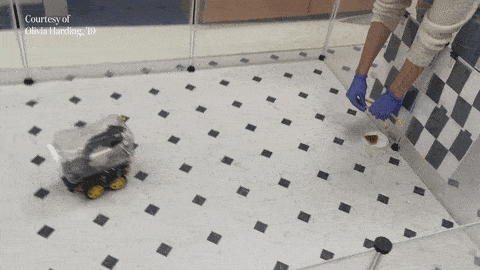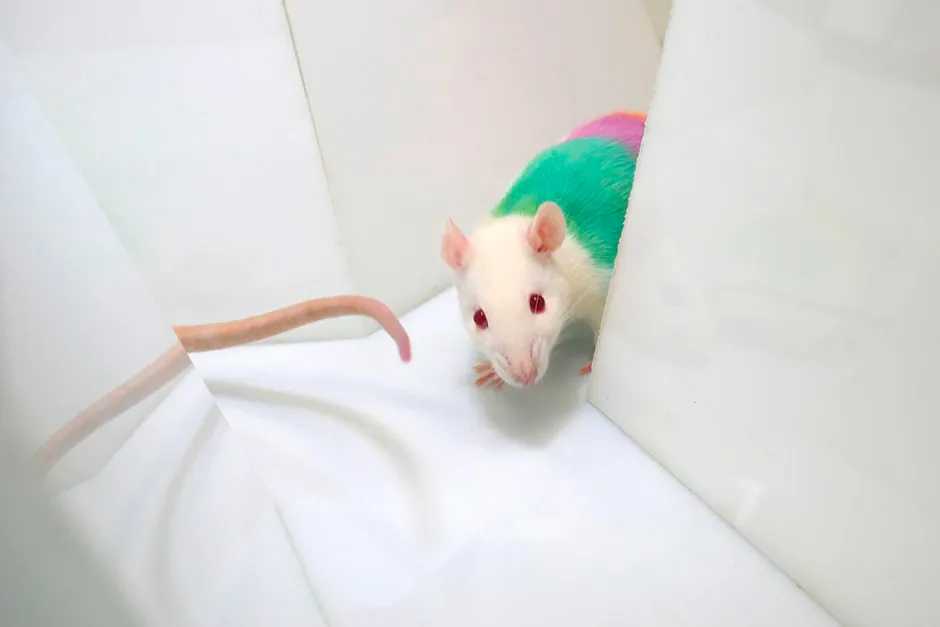Increasingly kept as pets, rats are less universally adored than our dogs & cats, but that doesn’t mean they are any less interesting. When a rat scurries across a patch of grass, what do you think of them? Some find them endearing, others are repulsed. You might be frightened, but what if they were driving or wearing a medal for bravery? Whatever your opinion, here are thirteen facts about rats that satisfy the curiosity we all have.
Read more scientific animal facts:
- Nine things you didn't know about dogs, according to science
- Eight mind-blowing facts about cats, according to science
1
Rats can dream
While they don’t all dream of becoming a chef like Remy in Ratatouille, research suggests that rats do dream about their future. Such dreams are often associated with goals, like reaching food previously spotted in at the end of a given pathway.
Electrode measurements in active and sleeping rats lets us see their brain activity in different scenarios. Coined “place cells” by Nobel Laureate John O’Keefe, specific combinations of neurons (communication cells that we can excite with electricity) correspond to These help rats and humans alike build internal maps of our surroundings.
Researchers watched the same place cells light up not only when rats are in a particular environment, like a path in a maze, but also when sleeping. We may never know the exact details, but it seems like the rats were dreaming about their travels.
Even when rats cannot physically experience the environment, the place cells associated with this route are observed to fire up. Scientists showed rats a route with a treat at the end but a barrier to entry, and left them to rest. Following their snooze, the rats were returned the route, now without the barrier, and the place cells activated corresponded to their sleeping brain activity.
2
They can drive (and without road rage)
Not only have a few rats learned to drive, but driving reduces their stress levels – though they are yet to face rat racers overtaking them from the inside lane.
A team led by behavioral neuroscientist Professor Kelly Lambert trained 17 rats to steer and drive towards food treats, finding that the activity relaxed the rats. They didn’t squeak up “oh, what a lovely journey”, but the calming effect was measurable in the changes in their stress-related hormone levels.

Corroborating previous research from Lambert’s team, the improved stress levels may result from successfully completing difficult tasks.
How do we know they’re not just satiated and calm from receiving food after driving?
For comparison, researchers measured the hormone levels of rats who were passengers in remote-controlled cars (or Ratmobiles, if you will). Rats allowed to drive had lower stress levels than those simply carted to the food, suggesting that “self-agency” in learning or exhibiting this skill plays a role.
3
Rats were among the first space travellers
In August 1960, Soviet satellite ‘Korabl-Sputnik 2’ carrying many animals orbited Earth, safely returning the next day. All animals arrived back healthy, paving the way for the first human spacecraft orbits Earth. Although the dogs aboard this trip have had their story told, we don’t know much more about these rats’ day in space.
4
Rats have travelled the world with humans
Back on Earth, rats were travelling long before learning to drive. Working with New York City street rats, scientists found that their genes have adapted over time to align with their new habitat.
Through their travels, rats have evolved to thrive around humans – hopping on our ships to find their new homes, they had to change their behaviour and diet to survive. With only some early stage findings linking rats’ genetic changes to their environments, researchers are keen to keep studying the flexible little creatures.
5
Rats live on all but one continent
For those of you who need to escape a fear of rodents, Antarctica is the continent free of rats, if you can withstand its icy chill. Scientists found this is one habitat that rats can’t yet make home. Either way, make sure you avoid the Bronx bus stops in New York.
6
Rats' eating habits are weirder than you think
Between scooting around and their space travel, rats need to eat. Rats snack almost every chance they can and – as holes in wooden skirting or ruined chargers can attest – rats will chew on almost anything.
7
Why do they nibble through your favourite shoes?
In part, rats’ incessant chewing is because their teeth never stop growing. To avoid the overgrown teeth, rats frequently bite, chew, and grind their teeth. Most rats we encounter are omnivores, but scientist have found that some rats are actually herbivores, following plant-based diets.
Rather than concerned about climate change, these “vegan” rats have diets dependant on a range of factors including the particular species and their environment.
Hoffmann’s rats are rainforest species, foraging mostly for fruit and seeds, while African crested rats have been described as “little cows”, chewing on poisonous plants (serving up protection, too). Across different species, rats can be found to sinking their ever-growing teeth into a range of foods.
Less likely to suffer from this gnawing problem is the Sulawesi Island rat, having evolved to be almost toothless. However, if you’re taking care of common brown rats, it’s best to buy them some chew toys to prevent obesity while keeping their teeth trim.
8
Rats are surprisingly smart
Those pesky rodents picking at your bins aren’t as lazy as they seem. Their scrounging has been praised as clever adaptability, helping them survive the climate crisis.
Further support of their intelligence lies in the fact rats can understand cause and effect. They form expectations based on such links and align their actions with an expected result.
Moreover, rats react with signs of regret when they have made a wrong decision. Metacognition, this ability to reflect on decisions, was recognised as in these clever creatures over a decade ago.
9
Rats have extraordinary senses
Feeling around in the dark to sense our environment is common in humans (fumbling for a door or tap in the night). Similar behaviour exhibited by rats, but instead of fumbling around, they modulate their whisker movements to delicately feel their surroundings and avoid collisions.
These clever rats move their whiskers in three dimensions, helping improve their movements in a given environment.
Like dogs, some rats have an exceptional sense of smell. Researchers trained African giant pounced rats to diagnose tuberculosis (TB), after discovering that they detect the scent of molecules released by the TB bacterium.
Other rats can recognise smells exposed to them while under anaesthesia. Without recalling the event of exposure to the smell, the smell was not registering as novel, indicating a level of sensory memory.
10
Rats are incredibly sociable
Not only can rats drive, make decisions, and sniff out certain diseases but they are also highly sociable creatures. It’s generally advised to house rats together, and this supported in science.
Rats are social, and show signs of depression when isolated, compared to rats housed with another rat. Young rats (or kittens, for baby rats) engage in play-fighting and since 2003, researchers have suggested that rats enjoy playing. Some scientists have even measured what sounds like laughing when rats are tickled, though our ears alone wouldn’t detect this.
Most recently, scientists shared the universal game of hide and seek with six rats. They learned and improved their hide and seek strategies when motivated by playful interactions.
With brain studies, researchers observed the rats exhibiting more positive reactions when they were directly involved in play compared to watching other rats have fun. Like humans, rats don’t like being left out. Ecologist Dr Sara Weinstein was surprised to find that even wild African Crested rats are sociable – but don’t get too close without a pair of gloves.
You might be surprised to hear that rats are also capable of empathy. Studies have found that they exhibit “emotional contagion”, becoming stressed when watching other rats are suffer.
11
Rats are team players
They can get up to mischief (so much so that 'mischief' is the name for a group of rats) – fighting and stealing our leftovers, but rats work well together to solve problems.
Scientists found that rats performed better in a group than individually, strategising and working together. Distinguishing between rats by dyeing their fur, the researchers found that they completed maze tasks significantly faster as a group, even making time for play-fights and grooming.

Researchers also found rats worked better together in perceiving danger and adapting defence mechanisms. In the research studying rats’ empathy, pairs of rats were discovered to transfer distress. Distress was heightened by observing another rat’s fear or suffering even without directly experiencing the external stressor.
Moreover, when one rat perceives another’s calmer response to a stressor, it measurably decreases its stress response. Researchers suggest that in doing so, rats in teams more efficiently anticipate and prepare for danger.
Researchers put this motivation to the test, to see if rats could be swayed from team work if it benefited them individually. Offering treats to rats as encouragement failed to eradicate the rats’ empathy for each other, and they continued to avoid harming their teammate.
12
A rat has been awarded a medal for bravery

Magawa, a giant pouched rat from Tanzania’s dedicated HeroRAT centre, is the winning rat. Trained to use that incredible sense of smell and his memory, Magawa finds explosives based on their scents.
13
Rats have made heroic contributions to medicine
Off the minefield, observing rats’ behaviour, health and disease resistance has allowed researchers to understand and develop in the field of health. Rats have helped researchers progress towards lowering people’s blood pressure by improving staple foods like rice.
Studies from rats fed genetically modified rice to include compounds considered to lower our blood pressure without the side effects of our current drugs. Researchers measured improved blood pressure in the rats, with no apparent side effects.
Beyond this, naked mole rats have advanced medical understanding in the field of resistance, and are helping us in the fight against cancer. A team at Cambridge found that while cancer cells can develop in naked mole rats, their immune system appears to stop the cancer in its tracks. Further investigations into their biology will help us understand and work against cancer in humans too.
Whether preventing cancer or an explosion, we can thank our furry friends for their heroic contributions.
